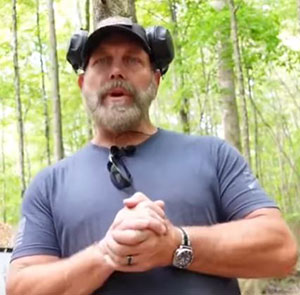 Hey guys. Brian Hill with a complete combatant give you an exercise to work on neuroplasticity. The brain has a big need for visual computing power and intends to overcome other systems if they're not in use. We know with a phantom limb syndrome that the brain adapts after the loss of a limb and it overcomes that. It takes it. You're changing constantly, so whatever you pay attention to, the brain's going to put a bigger emphasis on that and gobble up space. And secondarily, a lot of times when we're shooting much like a blind person, this is not permanent like it is for them. But if you lose your sight, your other senses are ex accentuated because the visual cortex is not being used. I find this with red dot shooters a lot. They always tell me they can't find the dot. Now we know objectively the.is inside the radical unless the optic is broken.
Hey guys. Brian Hill with a complete combatant give you an exercise to work on neuroplasticity. The brain has a big need for visual computing power and intends to overcome other systems if they're not in use. We know with a phantom limb syndrome that the brain adapts after the loss of a limb and it overcomes that. It takes it. You're changing constantly, so whatever you pay attention to, the brain's going to put a bigger emphasis on that and gobble up space. And secondarily, a lot of times when we're shooting much like a blind person, this is not permanent like it is for them. But if you lose your sight, your other senses are ex accentuated because the visual cortex is not being used. I find this with red dot shooters a lot. They always tell me they can't find the dot. Now we know objectively the.is inside the radical unless the optic is broken.
So it's their perspective relative to the.is messed up. Now the first thing they have to really think about is why are they not standing in a place where they can see clearly? What happens is they don't develop a good kinesthetic index on the draw so they're not aligned. One of the great ways to train basics is not to do the same thing over and over, but we're going to take vision away from it. So we're going to do some draws With our eyes closed. When our eyes are closed, we have to feel more. The more concrete feeling we get on our alignment, the better and easier it'll be to find the dot. Alright, so if I was standing here, I'd start in this first position. Let's unload and show clear. We're good. Okay, and what I would do is just close my eyes and see if the dot stays there. Now it wandered slightly to the right, so I'm on a hill, I'll adjust a little bit.
Alright, it was very still that time, so we're good. Now I'm going to close my eyes and press the trigger. Nothing really moves, so I'm in good shape. Now I'm going to do extended prep and press eyes closed, extend dead where I wanted it to be. So we're in good shape. Now I'm going to do hand on the gun with my eyes closed. Good, but it's a little high in the window, so that means I didn't quite finish these stroke that I needed to. Let's try that again. Hand on the gun, eyes closed. Connect the support hand, and it's right where I needed to be. So there's my first correction that I got from not seeing it. I'm feeling it. And now the correction is how does this hand work and how can this one relax? Now the full draw stroke pretty good. Off to the right, just slightly the right hand felt really tense. So I'm going to relax that a little bit.
And there it is. Now what's happening, since I can't go looking for the dot, I have to feel where it is and I get to concentrate on the support hand. Now, you can do this in the live fire. I wouldn't recommend doing a full draw with your eyes closed and pressing the trigger. But in order to develop confidence, what you can do is simply aim the gun in a hard target, close your eyes and impress the trigger. You're going to stay on paper, but it shows you how much you move after you align everything and it'll allow you to start feeling the trigger better. That's what we're going to do next, right? Going to shoot the triangle here. I'm very close and that's the purpose. So my berm can take up all the activity in the background and it can catch all the rounds. Alright, dots on the top of the triangle, eyes closed.
All right, and I got a shot right where I wanted it to be. So it's dead center right underneath this. That means that I was really connected with the feeling of my trigger finger. So once again, close your eyes. Develop the trust in the grip, isolate the skill of what it feels like to draw well and to orient your body to the target joints. Everything should be aligned with the target. Once you get better with that, you're going to find the dot with an astounding amount of regularity because we're simply going to confirm what a good draw feels like and know that the gun is aligned, and then we will align whatever precision we need with the vision. I hope that helps you out, guys, as always, measure, refine, and perform. I'm Brian Hill with a complete combatant and I look forward to seeing you on the range.
YouTube Video Link: https://www.youtube.com/watch?v=1kApWm_2HrA
Credit: Brian Hill, The Complete Combatant
